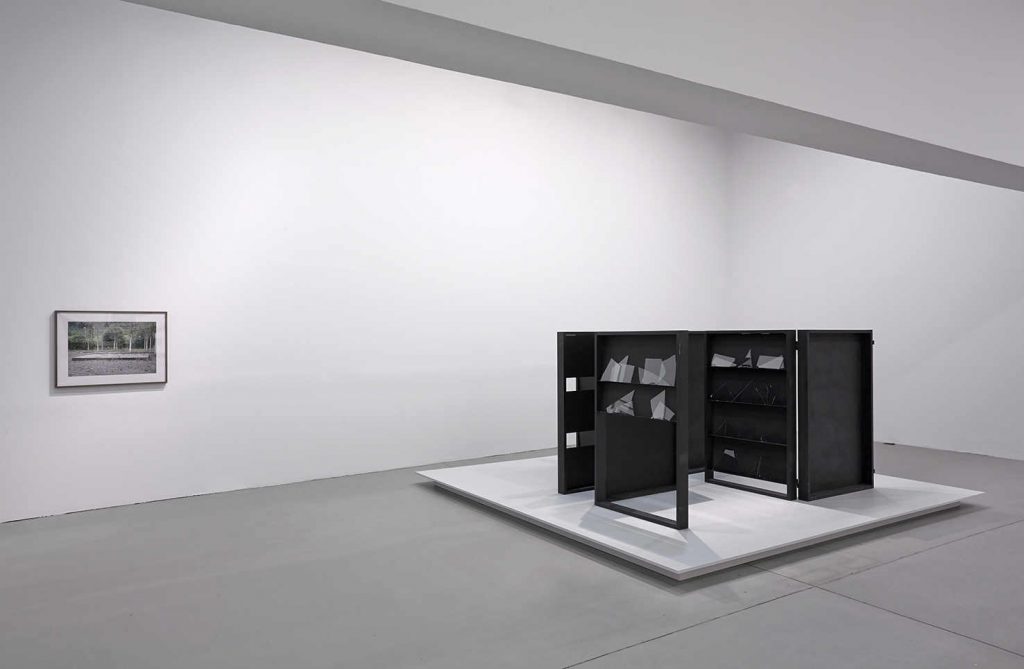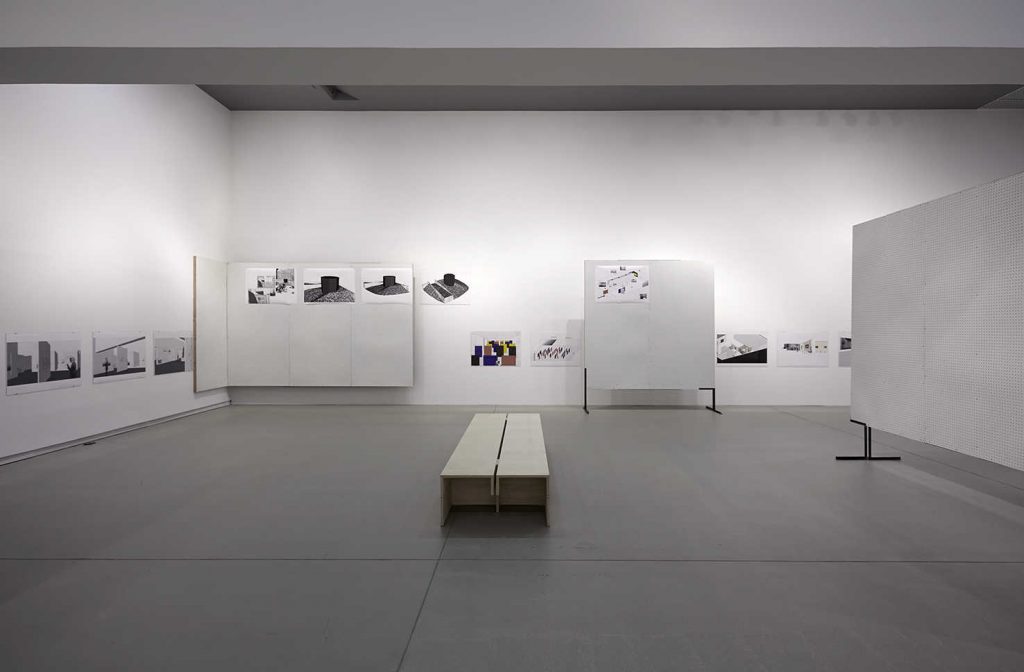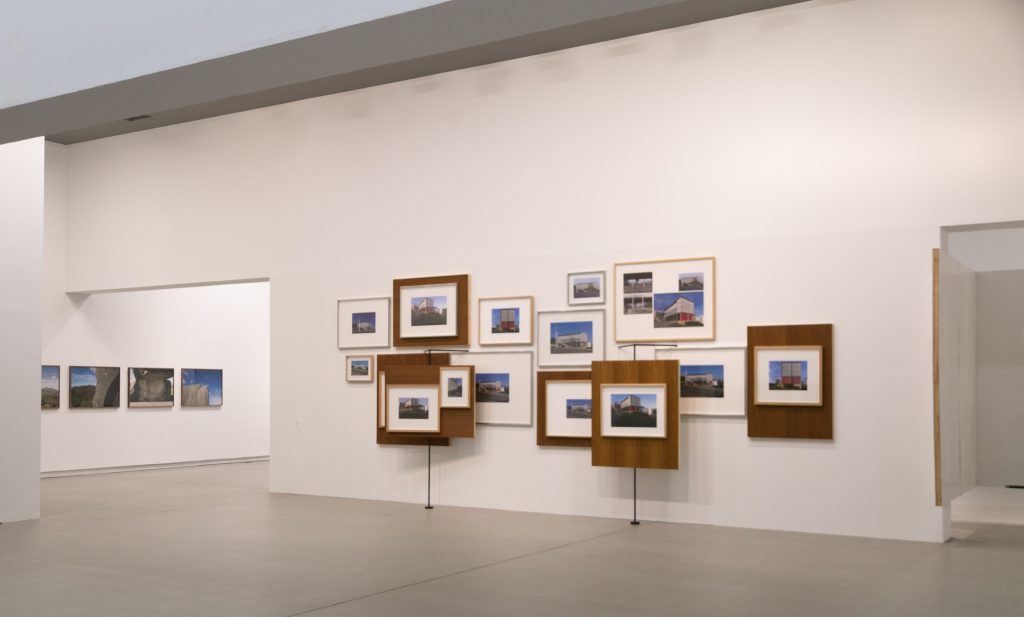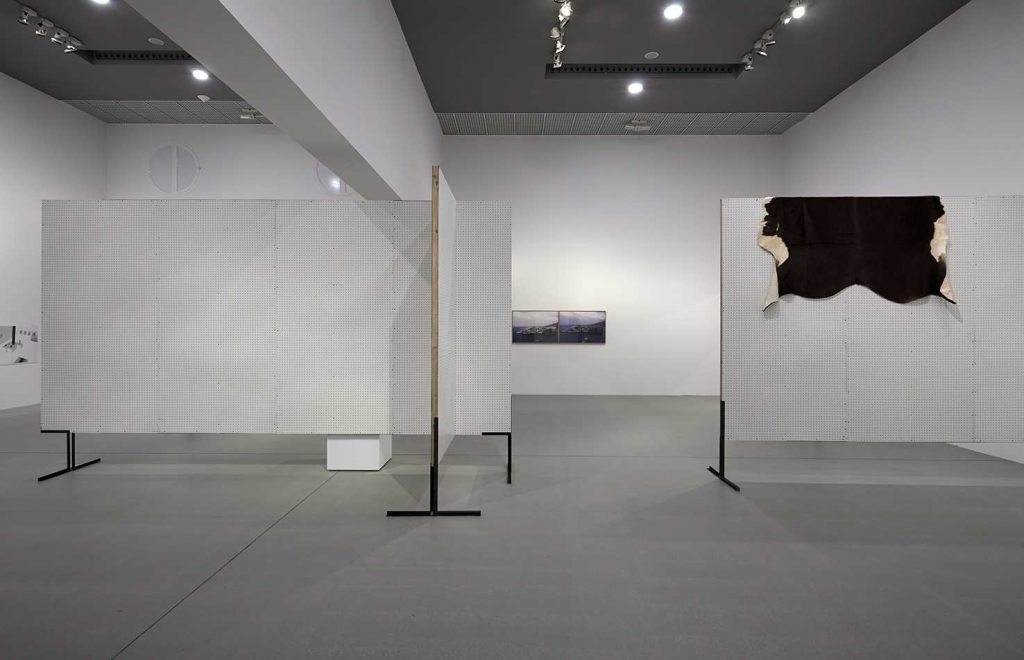The art of Xabier Salaberria deals with how collective dreams and qualities have materialised in their coming and going through modernity and our present-day. Working through the constructed character of history in displacements and remainders of social spaces and systems of representation, his work can be said to travel in time to revisit major keys in the public life of the West: as Isabelle Stengers puts it, a major key identifies a “centre stage” for thinking that constitutes an all-encompassing vision – social, theoretical, political, or aesthetic – that is defined by an “‘either/or’ disjunction”, something there is no getting around. In Salaberria’s case, we can borrow Stengers’ term and apply it to his focus on spatial practices, and to how his works revolve around “centre stages” of public life that there are no getting around: the city, the forum, the social model, the exhibition space.
Una exposición sin arquitectura (An Exhibition Without Architecture): given that aesthetic problems cannot be solved in the social sphere, art offers, at its own limits, the possibility to re-think the preconditions of the social. The exhibition’s title is derived from the Italian architect Andrea Branzi’s notion of a city without architecture. In the late 1960s, Branzi produced, together with the Archizoom group of architects, a plan for a future urbanity called No-Stop City. It was a theoretically and politically motivated example of urban planning that radicalised ad absurdum the rationalist legacy of modern architecture. Branzi writes about the group’s project: “The idea of an inexpressive, catatonic architecture, the outcome of the expansive forms of logic of the system and its class antagonisms, was the only modern architecture of interest to us: a liberating architecture, corresponding to mass democracy, devoid of demos and cratos (of people and of power), and both centreless and imageless. A society freed from the rhetorical forms of humanitarian socialism and rhetorical progressivism: an architecture that gazed fearlessly at the logic of gray, unaesthetic, and de-dramatized industrialism […]”.[1]
Throughout modernity, rationalised society has converted qualities into functions and economic relations: this is the precondition for modern urban life that Archizoom took as the empirical precondition for their dreamless citta senza architettura. When this becomes the title for a show that patently contains much architectural imagery, it is a logical extension of Archizoom’s theoretical exercise – although in Salaberria’s version, it is a standpoint that rather becomes an archaeology of, and an afterword to the radical response that Archizoom ended up giving to the crisis of modern architecture.
Also haunting the title of Salaberria’s show is Robert Musil’s novel The Man Without Qualities (1930-1942), in which the protagonist leaves it to the outside world to form his character – a literary precursor, perhaps, to Archizoom’s programmatic disenchantment of architecture. However in Salaberria,it is human society rather than the human subject that is deliberately left as a blank. In his work, there are no fantasies of “the beach underneath the asphalt”, but respectful investigations of social models devised to improve society, in which he checks our impulse to project figurative qualities onto the future. This is how we may be able to theorise what life – what kind of “freedom, brotherhood, and equality” – exists over and beyond existing reality. If, as Gilles Deleuze once remarked, being leftist means to orient oneself towards the future, to think a little further ahead, this is in a general sense also where the leftist political project intersects with art: art can be defined as that which is not yet identified by culture at large, not yet known or purposeful. This does not mean that art is inherently leftist, only that it is not (yet) a thing or a product, that it is not something stable and known. By the same token, the aesthetic experience is an overlooked precondition for comprehending social conflict.

At the limits and on the frontiers you encounter power and its contestation. A sculptural display system in steel, recalcitrant and black, whose doors can be flipped open, contain a display of broken glass like a dutiful in-kind documentation of the results of a street fight. This is a manifestation of militant dissent, and with this, of an end point of modernist architecture’s veneration for glass as a utopian material: glass opens up built space, the crystal splits time. What time-space does the smashed window, the broken crystal allow us to enter?
Another uncertain or shifting terrain is shown in a photograph whose title is not The Monuments of Passaic, as in the American artist Robert Smithson’s famous 1967 photographs of unremarkable industrial landscapes in New Jersey, but Pasaia (Mountain) (2008). The main motif is an enormous heap of scrap in the Gipuzkoan port city mentioned in the title. Pasaia was once an industrial an entry and exit point of cars, goods and immigration from other parts of Spain; now there is a plan to modernise the harbour to make it a hub for new economies and urban speculation. Salaberria took the photo from a zone with restricted access, after having asked for permission from the Civil Guard. This is not a place that you are meant to be, although it is difficult to see why not. The picture looks like the camera was placed directly on the ground: the entire foreground is blurry, which makes the mountain of rubbish look like it is about to tilt down towards the viewer. The portrait of a heterotopia, or a limit terrain, recurs in the two photos Perejil (2015), which repeat the same motif, namely a small strip of land on the Moroccan coast of which the Spanish government claims ownership. Home to a few seagulls, these contested rocks are in Salaberria’s work doubled like an imperial hallucination that has returned from the past. Permission for taking the photos also had to be obtained in this case.
Stripped of their original intention and telos, the historical objects that Salaberria deals with – buildings, urban zones, works by other artists – seem to move sideways in time. They become vessels that assume a paradoxical relation to their apparent physical solidity and non-negotiable placement, by revealing themselves to be unstable time pockets of matter and meaning. They are not exactly ruins; instead it is the case that the meaning-giving structures that once built them have fallen into disarray: that is, a structural displacement of the ruinous into the realm of the symbolic. No longer guarantors of civilizational promise (progress, social amelioration, cultural hegemony, etcetera), these are sites and edifices that are loaded with more or less remote, more or less obsolete, meaning, like social hieroglyphs. They no longer speak loudly, but breathe their significance and effects, as elements that tell of how societies have attained their qualities and imagined their future reproduction.
Salaberria’s works always seem ready to retire from the space of art, lapse unassumingly into functionality and use value and become a shelf, a hammer, a documentary photo. But there is also inevitably a strong pull in the other direction, towards the monumental and the autonomous. Caught in this dialectic, and inevitably marked by the surrounding world, monumentality and autonomy are in Salaberria’s works already indexed as very relative entities. Nonetheless, at least they maintain a power to make social function and use value doze off, when you consider a given object from their vantage point. If the sleep of reason produces monsters, the sleep of function makes apparent the systems into which a cultural object is inscribed. When a tool becomes afunctional, it is fundamentally out of order, in the sense of being removed from the ordering mechanisms and political economies that once defined it. The system that privileges Salaberria’s practice is obviously that of art, but this too is unstable, because it in his case is informed and criss-crossed by other practices and knowledges, such as architecture, engineering, industrial and graphic design, which all become part of his artistic anthropology.

As a result, Salaberria’s practice is itself open to disciplinary negotiation, often agreeing to be displaced from the centre of artistic enunciation. His search for the shared limits of art and the social sphere makes it necessary for him to de-centre, or re-purpose, himself as an author. Accordingly, his authorial function can end up in the realm of applied art, as he moves from artist to being curator and exhibition designer and enters into an intimate, care-taking dialogue with the work of other artists. If his general material orientation is toward spatial structure and the sculptural, his works are conceptually speaking edgy and flickering – not static and immobile: the sign of art loses its hermeneutic privileges, as Salaberria’s unmoors it from its place at the top of the cultural hierarchy. Played out on a horizontal terrain of social and cultural production, it is opened up to the status of a methodology, rather than residing ontologically in certain objects.
The term ‘design’ tends to enhance the operative side of the social world, connoting legibility and user-friendliness. In Salaberria, however, art is not reduced to a service through design, but is characterised by an expectant attitude toward the future event. The public sculpture Platform from 2002, located in the garden of the art institution Arteleku in Donostia, is the manifestation of a zero degree of public design: a laconic, rectangular slab of concrete offers nothing but an abstract surface awaiting human bodies or other agents to activate it. In the photos of the work, it is populated with colourless autumn leaves. It could be a dance floor awaiting music and lamps, a monument of (or to?) failed local planning, or the foundation for a construction that is yet unimaginable. In this state of pervasive suspension that questions what constitutes a “centre stage”, various scenarios flicker across the platform as a horizontal screen. Form, function, site, material and imagination interact in unresolved temporalities: what is it going to be? What will take place here? Etcetera. As in much of Salaberria’s other work, the first impression of Platform is that of a space being held open for us to populate: we, the viewers, bring our own bodies and histories along, of which we are collectively part.
Una exposición sin arquitectura: the exhibition itself is an aesthetic statement, a designed and authored apparatus or dispositif with its own enunciation that is more than, and different from, the sum of the works it contains. Salaberria’s exhibition title obliterates ‘architecture’, but ‘exhibition’ is seemingly left untouched. However, the exhibition as such is no less of an object for Salaberria’s investigations, and his show at Artium is in this way also a performative space that is charged through the tangle of twentieth century history, art history, and exhibition history.

Let us dive down the rabbit hole opened up by a series of photos of the 1992 reconstruction of the Republican Pavilion at the 1937 Paris World Exhibition. With a design by Josep Lluís Sert and Luis Lacasa, and including works by Alexander Calder and Pablo Picasso, the Pavilion was an example of avant-garde art and innovative engineering with light and prefabricated materials. Located in the vicinity of the pavilions of the Soviet Union and Nazi Germany, the Republican exhibition presented two works of art that made for a strange juxtaposition of anti-fascist modernism: Picasso’s Guernica – of course – and Alexander Calder’s Mercury Fountain, the latter a much less famous, but no less fascinating piece that shares with Picasso’s painting not only a reference to the attack by fascist forces on the Spanish population and government, but also contains a dark foreboding of the cataclysm to come.
We know that the German artist and designer Arnold Bode visited the World Exhibition and was greatly impressed by the Spanish Pavilion. By then, as a socialist he had already suffered confiscation of his own artwork at the hands of the National Socialists; a crime he would seek to avenge by founding what is probably the Cold War era’s most successful art exhibition series: documenta. Arnold Bode saw Guernica again after the Second World War, this time at a Picasso exhibition at Milan’s Palazzo Reale in 1953, where exhibition architects Gian Carlo Menicheti and Piero Portaluppi had dramatically staged Picasso’s anti-war painting against the ruinous walls of the war-torn exhibition venue. Bode now knew how to launch documenta, when the chance presented itself to make a comprehensive survey show of modern art in his hometown of Kassel in 1955: he would organise an exhibition in the Museum Fridericianum, which British bombings of Kassel had left in ruins. Bode’s architectural staging of modern art was elegant and effective. He did not ignore the war as a rift in history, but made it a part of his display. Documenta’s artistic director hereby raised awareness of the abyss of the war – but only to conceal it again: Bode hid the specificity of the war in plain sight by aestheticizing the ruin of the Fridericianum, thus precluding the possibility of a proper politics of remembrance. As art historian Julia Friedrich writes, the ruin-turned-art exhibition “concealed what could not be shown of Guernica, Warsaw or Leningrad. The war was visible, but its very presence displaced the obvious questions, given Kassel’s military tradition, of who had begun it and to what ends. The question of war crimes and culpability became blurred in Bode’s precise staging, which evoked a vague state of entanglement that encompassed both protagonists and victims, precluding differentiation between the two”.[2]
Guernica was not shown at the first documenta in 1955. It was far too political – read: communist – a work for the Western-aligned documenta. However, Picasso could not be ignored, so Picasso prints were instead shown in the documenta café, as well as paintings such as his Girl Before a Mirror (1932). Many paintings at the show were presented on an elegant display system that Bode had devised because the walls of the Fridericianum, pockmarked by shrapnel, could not be used for hanging. Paintings were instead installed on large wooden panels, held suspended in the air by thin metal tubes from floor and wall. In Salaberria’s exhibition, the photos of the reconstructed pavilion of the Republic are hung on a copy of this display system – which was not Bode’s own, but one that he had also spotted at the Palazzo Reale in Milan.
As taciturn as Salaberria’s works appear, once you start probing them, they are as deep as the histories they leap from. He commissioned the photographer Manolo Lugillo, who has documented the urban development of Barcelona since the 1970s, to take pictures of the reconstruction of the Republican Pavilion. This was made for the 1992 Olympics in Barcelona – but this anachronistic transplant across Europe and the twentieth century that gave the historical building a new symbolic charge is another story that grows into the political and urban imaginaries of the 21st century.

That the relationship between art and the social cannot be a transparent major key, or a stable centre stage, is made clear in a new series of photos of Jorge Oteiza’s monument for Father Donostia from 1958. In the images, the rectilinear square that rigorously framed the circle cut into the stone seems to have been nibbled by the blue sky over the mountain Aiako Harria: in fact, it is the case that the corners and edges of the monument were hammered away when an attacker vandalised it in 1992. Salaberria’s portrait of Oteiza’s sculpture is also one of how art consists of so many inextricable relations, to which the violent rupture that gave Oteiza’s piece its present (un)form adds another layer.
[1] Pier Aureli, The Project of Autonomy, Princeton Architectural Press, 2008.
[2] Julia Friedrich, “Mending the Rift with Art. Traces of National Socialism in the first documenta”, in Gross, Blume, Pooth, Voss, Wierling and Bang Larsen (eds.), documenta. Politics and Art, Deutsches Historisches Museum, Berlin, and Prestel Verlag, Munich, 2021, pp. 60-68.
